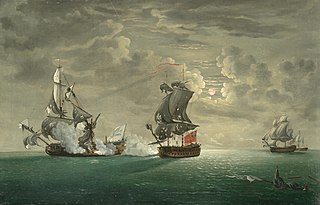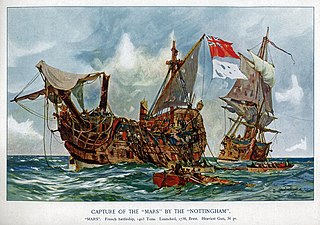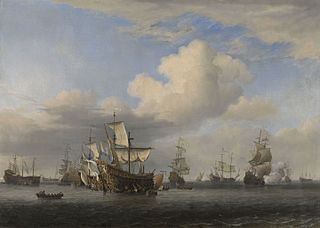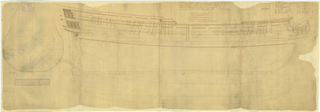
HMS Monmouth was a 66-gun third-rate ship of the line of the Royal Navy, and was likely named for James, Duke of Monmouth. She served from 1667 to 1767, winning ten battle honours over a century of active service. She was rebuilt a total of three times during her career—each time effectively becoming a completely new ship.

HMS Royal Oak was a 74-gun third-rate ship of the line of the Royal Navy, built by Jonas Shish at Deptford and launched in 1674. She was one of only three Royal Navy ships to be equipped with the Rupertinoe naval gun. Life aboard her when cruising in the Mediterranean Sea in 1679 is described in the diary of Henry Teonge.

HMS Nottingham was a 60-gun fourth-rate ship of the line of the Royal Navy, built at Deptford Dockyard and launched on 10 June 1703. She was the first ship to bear the name.

HMS Prince was a 100-gun first rate ship of the line of the Royal Navy, built by Phineas Pett the Younger at Deptford Dockyard and launched in 1670.

HMS Warspite was a 70-gun third-rate ship of the line of the Royal Navy, launched in 1666 at Blackwall Yard. This second Warspite was one of the five ships designed to carry more provisions and lower deck guns higher above the water than French and Dutch equivalents. In 1665 the Second Anglo-Dutch War had begun and on 25 July 1666 Warspite was one of 23 new English warships helping to beat a Dutch fleet off North Foreland, Kent. She won again distinction on Christmas Day 1666 as senior officer's ship out of five sent to protect an important convoy of naval stores from the Baltic. Warspite next took part in the first action of the Third Anglo-Dutch War on 28 May 1672 off Southwold Bay, Suffolk. This desperate 14-hour battle, generally known as Solebay, was a drawn fight; but Warspite successfully fended off a pair of Dutch fire ships exactly as she had done off North Foreland. By 1685, she was mounting only 68 guns.

HMS Charles was a 96-gun first-rate ship of the line of the Royal Navy, built by Christopher Pett at Deptford Dockyard until his death in March 1668, then completed by Jonas Shish after being launched in the same month. Her name was formally Charles the Second, but she was known simply as Charles, particularly after 1673 when the contemporary Royal Charles was launched.

HMS St Andrew was a 96-gun first-rate ship of the line of the Royal Navy, built by Christopher Pett at Woolwich Dockyard under the supervision of Christopher Pett until his death in March 1668, completed by Jonas Shish, and launched in 1670. Commanded by George Churchill, she took part in the 1692 victory over the French navy at Barfleur & La Hogue.

HMS Edgar was a 72-gun third rate ship of the line of the Royal Navy, built by Baylie of Bristol and launched in 1668. The diarist and naval administrator Samuel Pepys visited the town during its construction, noting that in his opinion, "it will be a fine ship". By 1685 she was carrying 74 guns.

HMS Swiftsure was a 42-gun great ship of the English Royal Navy, built by Andrew Burrell at Deptford and launched in 1621.

President was a 38-gun fourth rate frigate of the Royal Navy, originally built for the navy of the Commonwealth of England by Peter Pett I at Deptford Dockyard, and launched in 1650.

HMS Hampton Court was a 70-gun third rate ship of the line of the Royal Navy, launched at Deptford Dockyard in 1678. Her initial commission was to move her to Chatham where she spent in the next ten years in Ordinary. She held an active commission for the War of the English Succession, participating in the Battles of Beachy Head and Barfleur. She was rebuilt at Blackwall in 1699/1701. During the War of Spanish Succession she served mainly in the Mediterranean. In 1707 she was taken by the French and incorporated into the French Navy for four years. She was sold to the Spanish in 1712. She was wrecked in Spanish service off the coast of Florida in a hurricane in 1715.

HMS Lenox was a 70-gun third rate built at Deptford Dockyard in 1677/78. She was in active commission for the War of English Succession fighting in the Battles of Beachy Head and Barfleur. She was rebuilt in 1699. Again in active commission for the War of Spanish Succession fighting in the Capture of Gibraltar and the Battle of Velez Malaga. She followed this with the Battle off Passero. She was rebuilt again in 1721. She was active in the War with Spain, capturing the Princesa then serving in Home Waters, the Mediterranean and finally the West Indies. She was in action off Havana in 1745. She returned home and was placed in Ordinary. She was finally sunk as a breakwater at Sheerness in 1756.
HMS Burford was a 70-gun third rate ship of the line built at Woolwich Dockyard in 1677/79 as part of the Thirty Ships Programme of 1677. She fought in the War of the English Succession, including the Battle of Barfleur, before being rebuilt at Deptford in 1699, remaining as a 70-gun third rate. During the War of Spanish Succession she was mostly in the Mediterranean fleet and fought at the capture of Gibraltar and the Battle of Málaga in 1704 before being extensively repaired between 1710 and 1712 at Portsmouth Dockyard. Burford served in the Baltic in 1715 and 1717 before returning to the Mediterranean to fight the Spanish at the Battle of Cape Passaro in 1718. She was wrecked on the Italian coast in a storm on 14 February 1719.

HMS Essex was a 70-gun third rate built by Sir Henry Johnson of Blackwall in 1678/79. During the War of the English Succession she fought in the last major action. She was rebuilt in 1699/1700. During the War of Spanish Succession she fought at Vigo Bay, the Capture of Gibraltar and Velez Malaga. She also fought at the Battle off Passero in 1718. She was rebuilt again in 1736-40. She was in action off Toulon in 1744. She was active in the Channel and against French ports during the Seven Years War. She fought at Quiberon Bay in 1759. She was wrecked in Quiberon Bay in November 1759.

HMS Expedition was a 70-gun third-rate ship of the line built at Portsmouth Dockyard in 1677/79. She was in active commission during the War of the English Succession participating in the battles of Beachy Head and Barfleur. She was rebuilt in 1699. Again, for the War of Spanish Succession she was in commission for the operation at Cadiz then returned to England where she sat for two years. She was in the Mediterranean for the Battle of Marbella in 1705. She then went to the West Indies and fought in Wager's action off Cartagena in 1708. She was rebuilt in 1709-14 to the 1706 Establishment. She spent her time split between the Baltic and as guard ship at Portsmouth before being broken at Portsmouth in 1736. She was rebuilt in 1736/40 at Deptford Dockyard.

HMS Suffolk was a 70-gun third-rate ship of the line of the Royal Navy, built by contract of 20 February 1678 by Sir Henry Johnson at Blackwall. She participated in the War of the English Succession 1689 - 1697, in the Battles of Beachy Head and Barfleur. She was rebuilt in 1699. She was actively involved in the War of Spanish Succession 1702 - 1713. Her later career was as guard ship duties, deployments to the Baltic Sea and the West Indies. She was finally broken in 1765 after lying in Ordinary for almost twenty years.
HMS Torbay was an 80-gun third rate ship of the line of the Royal Navy, launched at Deptford Dockyard on 16 December 1693. In 1707, she served as flagship of Rear-Admiral of the Blue Sir John Norris and belonged to Admiral Sir Cloudesley Shovell's fleet. She saw action during the unsuccessful Battle of Toulon and was present during the great naval disaster off the Isles of Scilly when Shovell and four of his ships were lost, claiming the lives of nearly 2,000 sailors. Torbay suffered little to no damage and finally managed to reach Portsmouth.

HMS Orford was a 70-gun third-rate ship of the line of the Royal Navy, launched at Deptford in 1698. She carried twenty-two 24-pounder guns and four (18-pounder) culverins on the lower deck; twenty-six 12-pounder guns on the upper deck; fourteen (5-pounder) sakers on the quarterdeck and forecastle; and four 3-pounder guns on the poop or roundhouse.

HMS Swiftsure was a 70-gun third-rate ship of the line of the Royal Navy, launched in 1755 and in active service during the Seven Years' War. After a distinguished career at sea she was decommissioned in 1763 and sold into private hands ten years later.
HMS Panther was a 50-gun fourth rate ship of the line of the Royal Navy, built at Deptford Dockyard and launched on 15 March 1703.
















